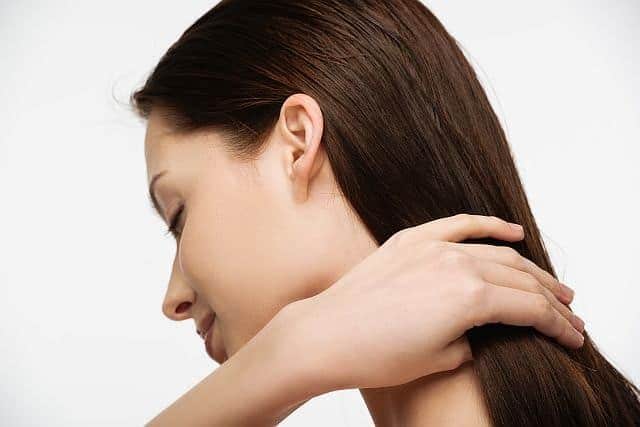Last Updated on December 29, 2022 by Gaga
Why Do Proteins Need to Be Broken Down?
The protein in your hair is vulnerable to damage from harsh cleansers, frequent chemical treatments, and heat styling, which can result in dryness, reduced elasticity, and excessive hair shedding.
Repairing this damage is more complicated than simply replacing the missing protein because the molecules are too big to penetrate the hair shaft and support the integrity of the hair.
To effectively repair this damage, proteins need to undergo a process called hydrolysis. That’s a chemical reaction that breaks protein molecules down into fragments with lower molecular weights that can be absorbed by the hair.

These smaller protein pieces can penetrate the hair shaft, replace the lost protein, and strengthen the hair from the inside. Hydrolyzed proteins help improve moisture retention and elasticity while giving hair softness, shine, and bounce.
Hydrolysis also makes protein water-soluble, and suitable for use in cosmetic formulations.
How to Use Hydrolyzed Proteins on Your Hair
These protein products deserve your attention because unlike synthetic chemicals that can damage your hair and pose a health risk, hydrolyzed proteins are completely safe for use in personal care products.
If your hair is fine, damaged, dry, relaxed, or difficult to style, you should consider hydrolyzed proteins as part of your hair care regimen. As you do, you will notice your hair looking and feeling stronger, fuller, softer, and shinier.
Hydrolyzed proteins are not finished personal care products, but concentrated raw ingredients that are meant to be used for making cosmetics or adding directly to your store-bought hair care products. (Don’t use these raw ingredients directly on your hair—they are too strong to be used without diluting.)
Be careful to avoid protein overload, because too much protein can leave your hair looking greasy and feeling brittle, especially if your hair already has enough protein. If that happens, deep conditioning treatments and moisturizing products will help get the protein/moisture balance back, but you should lessen the amount of hydrolyzed proteins in your hair care products and reduce the frequency of using protein-rich products.
The advantage of adding hydrolyzed protein to your hair care product over buying products that already contain hydrolyzed protein is that you can customize the concentration of protein according to your needs. To enable you to get the desired strength easily, some hydrolyzed protein products come with a measuring pipet and a percentage chart.
The most common types of protein that are used for making hair care products are hydrolyzed wheat, hydrolyzed silk, and hydrolyzed keratin protein.
Let’s see how your hair can benefit from hydrolyzed proteins and how to incorporate them into your hair care routine.
Hydrolyzed Proteins for Hair
1. Hydrolyzed Wheat Protein
This protein product is an amber-colored liquid derived from wheat. Due to its low molecular weight, it can penetrate damaged cuticle layers and strengthen your hair from within. This product doesn’t contain gluten, so it can be used if you are gluten sensitive.
Hydrolyzed wheat protein will last up to a year without losing its effectiveness. Store it in the refrigerator after opening it to preserve its potency.
Properties & Benefits
- Fine, porous, damaged, and chemically treated hair will get the most benefit from this protein. If your hair lacks protein, this will bring it back to life. You may see a noticeable difference after the first use.
- Hydrolyzed Wheat Protein reduces hair’s porosity and strengthens it from within, making your hair healthier, shinier, and easier to style.
- This protein increases your hair’s ability to receive and retain moisture.
- It helps reduce breakage, eliminates frizz and tangles, and makes your hair appear fuller.
Applications
Hydrolyzed Wheat Protein should be mixed with your moisturizing conditioner and used as a deep conditioner or protein treatment, depending on the porosity level of your hair. Make sure to follow the instructions that come with the product.
If your hair is overly porous and very damaged, you need to apply it as a protein treatment biweekly. If you have low porosity hair, use this protein product monthly as a deep conditioning treatment.
Try to avoid putting the mixture directly on your scalp because it can clog up your pores.
You can apply heat or just use a shower cap and towel for 30-45 minutes. Rinse thoroughly; otherwise, your hair may appear sticky or greasy.
2. Hydrolyzed Silk
Hydrolyzed Silk Protein is an amber, non-viscous liquid obtained from silk fibers. This water-soluble protein can be added to your hair care products at concentrations of 0.5 – 5% of the total amount of the product.
Properties & Benefits
- When added to hair care products, Hydrolyzed Silk helps improve the elasticity of hair strands and adds luster and manageability to the hair.
- Hydrolyzed Silk Protein fills in the gaps in the cuticle, giving more silkiness to your hair than any other hydrolyzed protein.
- Its outstanding moisture-binding capacities help increase the hair’s ability to retain water, improving its elasticity.
- When added to hair shampoos, it can reduce the irritating potential of harsh surfactants.
Applications
Hydrolyzed Silk Protein can be added to a hair shampoo or conditioner in concentrations of up to 5% of the total volume to increase the conditioning and softening properties of these products. Make sure that your shampoo or conditioner is rich in moisturizing ingredients to help keep the moisture/protein balance in your hair.
You can add Hydrolyzed Silk to your deep conditioner and apply it as a protein treatment every few weeks.

3. Hydrolyzed Keratin Protein
Hydrolyzed Keratin is a clear amber liquid with a strong odor. Its thin consistency makes it easy to mix with any water-based hair care product. Hydrolyzed keratin protein is usually derived from sheep’s wool.
Properties & Benefits
- Hydrolyzed keratin is a protein fragment that not only coats but also penetrates the hair shaft to replace missing keratin in microscopic gaps along the hair shaft, resulting in smooth and shiny hair.
- This product is not meant to be used for straightening your hair. It helps rebuild the hair’s natural protective layer, making it stronger and more elastic while reducing hair breakage and splitting.
- Hydrolyzed keratin increases the diameter of hair fibers, giving a fuller appearance to fine and thin hair.
- It also increases the hair’s ability to retain moisture and reduces frizz and flyaways caused by dryness.
- If your expensive salon keratin treatment has started to wear off, adding hydrolyzed keratin to your shampoo, conditioner or leave-in conditioner could help extend the time between salon straightening services.
Applications
Hydrolyzed Keratin can be incorporated into all kinds of water-based hair care products. You can add it to your shampoo and conditioner at a concentration between 0.5%-3%. The optimum concentration may vary depending on the condition of your hair. Make sure not to exceed the maximum concentration of up to 3%, because if you use too much of it, your hair may become stiff or look greasy.
You can also add hydrolyzed keratin to your deep conditioner and leave the mask in your hair under a shower cap for about an hour. Make sure to rinse hair thoroughly and follow up with a moisturizing conditioner.

Gaga is a blogger and founder of the Softer Hair website. She often says that insomnia is to blame for her first blogging attempts. Being the night owl, she hated the morning alarm. She left her office job and returned to what she loved most - writing.


Hi, I was wondering if you can use hydrolyzed silk or wheat and keratin in conjunction? And how do you measure by eyeballing them, Let’s say if you use a quarter-sized amount of your conditioner or shampoo is it like 1-2 drops of treatment?
Hi Susanne, I was wondering about the same question. I see there’s still no answer.
I saw certain products that have two or all three in the ingredients. But the reality is for me is the product never says how much of each…
I use all three: 2% keratin, 1% silk, and .5% wheat in my conditioners
Where do you buy this ?
You might try googling the answer to your questions or look at the Amazon website for ASIN: B0103UPJDY.
When they say 0.3 % – 5% what do they mean? That’s how much of ml or teaspoons?
The mixture made of your shampoo and hydrolyzed keratin will contain 0.3 % – 5% hydrolyzed keratin.